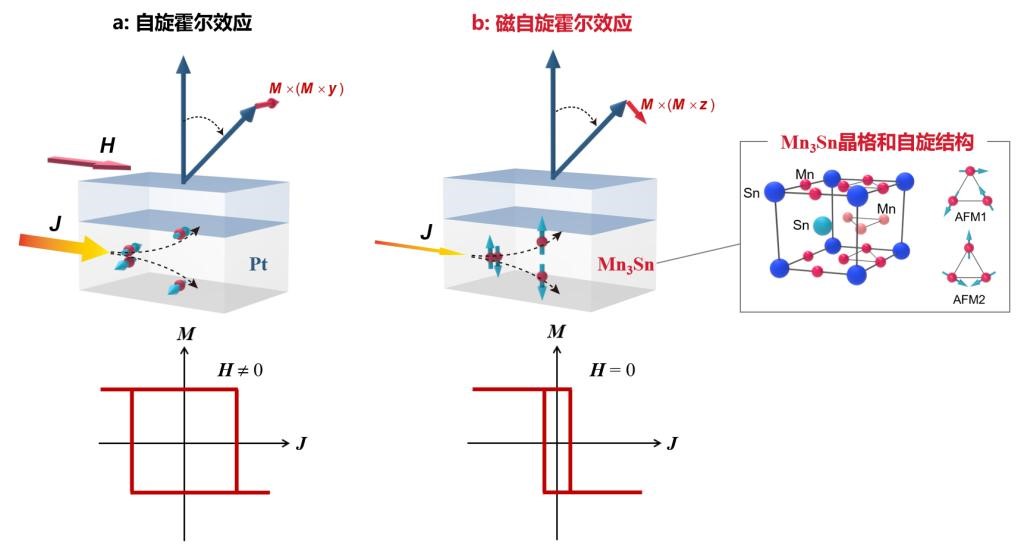Recently, Nature Communications published online "Efficient perpendicular magnetization switching by a magnetic spin Hall effect in a noncollinear antiferromagnet", a research paper by Professor QIU Xuepeng's team from the School of Physical Science and Engineering of Tongji University and their collaborators. Different from the in-plane polarized spin current generated by the spin current (spin Hall effect, and interface Rashba effect), the researchers used the magnetic spin Hall effect of the non-collinear antiferromagnetic material Mn3Sn to generate a novel odd plane out of the plane-polarized spin current, and drive the magnetic moment reversal for information writing efficiently. The research shows the important role of topological spin structure in spintronics, which provides new materials and mechanisms for ultra-low power and ultra-high-density spintronics devices.

Fig. 1: a. Conventional heavy metal Pt generates in-plane polarized spin current through spin Hall effect, and then generates spin-orbital moment on adjacent ferromagnetic layer. This effect requires a large current and auxiliary magnetic field to reverse the magnetic moment. b. Topological non-collinear antiferromagnetic material Mn3Sn generates an out-of-plane polarized spin current through the magnetic spin Hall effect, thereby generating a new spin-orbit moment for the adjacent ferromagnetic layer. Based on this effect, the magnetic moment can be flipped without a field at a small current.
It is of great significance to develop new spintronic devices (such as magnetic random- access memory, and spin field effect transistor) by using the spin property of electrons in magnetic metal heterostructures to promote a new round of information industry revolution. As the latest principle to realize the electro-magnetic regulation effect, the current induced spin-orbit moment (SOT) effect in magnetic metal heterostructures can efficiently drive the spin-flip, which is expected to become the mainstream technology of the new generation of spintronic devices. Currently, most SOT devices use the spin Hall effect in heavy metals to generate SOT (Fig. 1a). Due to the two-dimensional characteristics of the films and the inherent symmetry of spin Hall transport, the spin current polarization generated by the spin Hall effect is in-plane and perpendicular to the current direction. At the same time, the spin current has time inversion symmetry, and the spin polarization direction is not affected by the external magnetic field. To drive the magnetic moment to flip definitively in the vertical direction, the spin Hall effect SOT requires an additional in-plane magnetic field. The topological noncollinear spin arrangement in the noncollinear antiferromagnetic Mn3Sn breaks the time inversion symmetry of the spin current, resulting in the asymmetric distribution of the spin on the Fermi plane, generating novel out of plane-polarized spin currents (Fig. 1b). Compared with the in-plane polarized spin current in conventional heavy metals, the out-of-plane polarized spin current generated by the magnetic spin Hall effect in Mn3Sn can drive the vertical magnetic moment inversion more efficiently without the assistance of the in-plane magnetic field. In addition, the polarization direction of spin current in the magnetic spin Hall effect can be controlled by the external magnetic field flipping the spin chiral alignment direction of Mn3Sn. These novel physical properties break through the scope of the existing spin current generation mechanism and are expected to greatly promote the development of the new generation of ultra-low power consumption and ultra-high-density spintronics devices.
Dr. HU Shuai from Tongji University, SHAO Dingfu, a researcher from the Institute of Solid State Physics, Chinese Academy of Sciences, Dr. YANG Huanglin from Tongji University, and PAN Chang, a doctoral student from Tongji University, were the co-first authors of the paper. School of Physics Science and Engineering, Tongji University, and Shanghai Key Laboratory of Special Artificial Microstructure Materials and Technology are the co-first organizations of the paper. Researcher YANG Yumeng from Shanghai University of Science and Technology, Professor Evgeny Y. Tsymbal from the University of Nebraska Lincoln in the United States, and Professor QIU Xuepeng of Tongji University are the co-corresponding authors of the paper. Among them, YANG Yumeng, SHAO Dingfu, and Professor Tsymbal completed numerical simulations and theoretical explanations of the experiment. Professor ZHOU Shiming, the academic leader of the research team, Tongji University, made important contributions to the research. The research was supported by the National Fund for Outstanding Youth Program, and the National Key Research and Development Youth Program.
Paper link: https://www.nature.com/articles/s41467-022-32179-2.